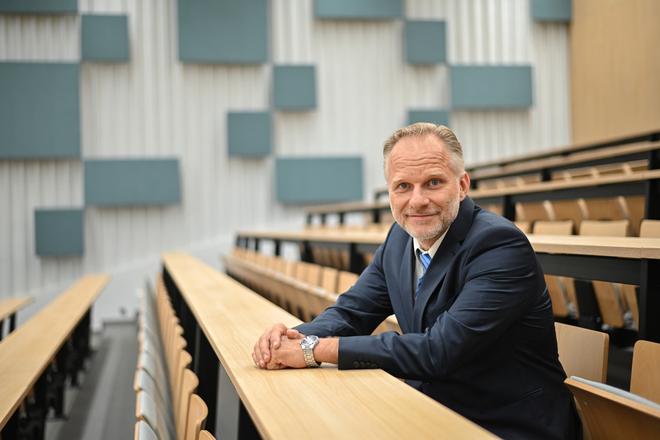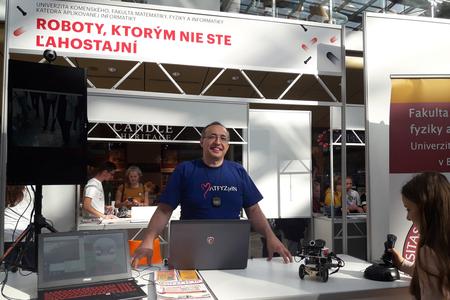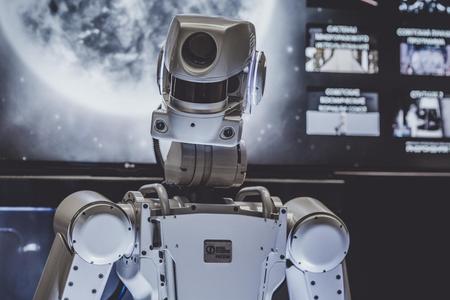Igor Farkaš, who won the ESET Science Award in the Outstanding Academic in Slovakia this year, is a leading Slovak expert on AI. A professor at the Faculty of Mathematics, Physics and Informatics at Comenius University Bratislava, the robotics research he and his team are doing is unique in the country.
Farkaš talked to The Slovak Spectator about his work, why robotics is focused on humanoid machines, how cognitive science can provide inspiration for robotics and AI, and why humanoid robots would provide the best help for older people.
Many movies have shown what a world with robots and artificial intelligence might look like. Are we already in one of those worlds? If not, how far are we from it?
Hardware-wise, robotics is advancing. When talking about humanoid robots, which are probably most interesting to many people, this field is advancing very quickly, with lots of investment. Just recently, a $16,000 humanoid robot was unveiled in China. That's an incredibly cheap robot. I'm afraid it won't be of high quality, but there it is. At the faculty, we have a small semi-humanoid robot worth €25,000. In a year’s time, we want to buy a €250,000 one. Hardware is important. The second thing is artificial intelligence; that is, for a robot to be of use, it must be equipped with abilities, and that involves a lot of work. First, motor skills, then sensory perception, then cognition. Experiments currently being carried out focus on elementary properties in simulated robots.
Simulated?
In the computer. A robot that learns in, say, virtual reality and can interact with a human. It's fast, cheap, safe. When a model is trained, it can then, theoretically - there are some practical limitations - be transferred to a physical robot. Training a physical robot would mean destroying it, because the sheer amount of repetition involved would break its joints, for example. Those movies are still science fiction, but I think it's only a matter of time before it happens.
To stay up to date with what scientists in Slovakia or Slovak scientists around the world are doing, subscribe to the Slovak Science newsletter, which will be sent to readers free of charge four times a year.
In recent years, a lot of discussion has focused on AI, not robots, although companies like Boston Dynamics have shown how far they've progressed with their Atlas.
Boston Dynamics has remarkable robots. Behind the tech is control theory, mathematical models, which means what they have is a precisely-described model of a robot, its geometry, its kinematics and so on, and they know how to create effective optimal algorithms for its control. It's very impressive, but it's not built on neural networks, as far as I know. I don't think the robots have a universal ability to respond to stimuli, although, of course, when you push one, it doesn't fall down. The field of AI, namely the subfield of neural networks based on machine learning and deep learning models, began flourishing 15 years ago. Currently, such AI is better at various tasks than humans, for example recognizing objects, classifying them, playing games. You may remember AlphaGo from not long ago – it learned strategies better than its human opponents.
AlphaGo made moves during games that at first surprised experts, but then turned out to be crucial. Isn't it interesting that despite the fact that AI is based on our knowledge, it is still able to come up with ideas that we would not have thought of?
One might say there is a certain amount of creativity. But this is also due to the fact that the AI plays many, many games against itself. So, it doesn't surprise me that much. It was a matter of time, even though [the abstract strategy game] Go is a more demanding game than chess. But recently it has been AI's language skills that have drawn attention.
Do you mean ChatGPT and similar language models?
Yes. They are intuitive, easy to use. There hasn't been much talk about robotics, but robotics goes hand in hand with AI. For example, there is currently a boom in various European calls. We knew that if robotics were to move forward, it would be necessary to equip robots with AI. Algorithms that are used for various tasks are also applicable in robots, but a robot also needs to move intelligently – something which is important, but difficult. It's actually quite a paradox. For us, motor skills are something we don’t even think about, but they are difficult for machines. It is difficult for humans to handle logical tasks, but it is easy for AI. So, in the next few years, there will be a lot of investment in how to use AI in robots.
What is the reasoning behind trying to create humanoid robots?
When communicating with a robot or a living object, we have a tendency to anthropomorphise it, attribute human characteristics to it. Makes for an easier communication. Humanoid robots are in the best position when we think of robots, for example, as helpers for old people. Robots should perceive us as humans and be very sensitive to human signals. We don't want humans to adapt to robots, we want robots to adapt to humans so the former's behaviour suits the latter's needs. We can't see into a robot's mind, but in principle we know that there is a model behind it, so we can know roughly what the robot is thinking.
In the debate around AI and robots, fears of a robot rebellion are often mentioned. To what extent is such a scenario realistic? Is it just a kind of human projection, because somewhere we know that we could do something like that and we construct the robots in our image?
It is one thing to misuse artificial intelligence for military purposes, which, of course, is a real threat, but it’s another to develop machines with intelligence that would allow them to realise there may be an advantage to getting rid of people. We are not there. A machine would have to be of a high level of intelligence to realise something like this. A system of values can be instilled in a machine.
Sort of like Asimov's Three Laws of Robotics?
Yes. Take training on data that would be in line with ethical and moral principles. I do not think we need to worry about this at the moment. We need to solve elementary problems, such as how to make robots effective helpers. This is more of a philosophical debate, one closer to science fiction. We need to follow the giants in Silicon Valley, where revolutionary ideas are born, where they are trying to look a step ahead, explore the possibilities.
You mentioned that you have a robot at the faculty. Why did you buy it?
Mainly for research. It is a semi-humanoid robot without legs, which would be useless for our purposes. Teaching a robot to walk is difficult, almost no one is doing it with current research robots. You also run the risk of it falling and breaking. The robot is also used for student projects. At the same time, it has also increased the faculty's attractiveness - thanks to the robot we are also working on a project to develop the workplace, we have partners in Germany and Italy. After a year of research, we have discovered some of limitations due to its cost, so we have to do experiments that don't require very precise motor skills.
What researching do you do on it?
For example, we want to teach it to pick up objects of different shapes. These must first be recognized, including their shape. This is practised in the simulator.
Where is this applicable?
I'm interested in basic research, I don't deal with applications so much, that's still in the future. These are essentially pilot projects; we are the first people in Slovakia doing something like this with a humanoid.
You are also interested in cognitive science. What interests you about the field?
It is related to AI. It is the science of how a person works, of cognitive processes, or thinking It can provide a lot of inspiration for robotics and AI.
How much do we really know about our brain?
There's the saying that the more you learn, the more questions arise. I think we know quite a lot. I don't know what it would mean to know absolutely everything. It depends a lot on the level at which we are investigating, whether at the level of neurons and ion channels, that is, how a particular neuron works, because that in itself is complex; or at the system level, i.e. as a whole. It seems to me we have a rough picture of how it works. Obviously, when you ask about specific areas, we run into some unknowns.
Of course, AI models reflect this. There are dozens of cognitive architecture models, some of which draw inspiration from our brain and how it is connected - that there are areas for vision, hearing, memory, etc., and they are based on neural networks. If we apply this to robots, say we have a block for vision, we have to consider what camera the robot has, the RGB image it receives. Say we have a block for moving, I connect it to its hand, which can move with certain degrees of freedom. Others are different, rather more abstract. We can use these models based on what we prefer.
When we take design inspiration from humans, isn't that limiting robots in some way?
On the one hand, it is good to be inspired by human abilities. There is something called cognitive AI, which is inspired by human cognition. The goal is to overcome the underlying problems. When it comes to vision, for example, a standard task is to classify an object which involves training a neural network on datasets with categories and the model can be excellent. However, we have known for a long time that such a model can be fooled by what is called adversary inputs. This is a targeted change of, say, two pixels in an image, causing the model to think it is looking at a farm tractor instead of a dog. This cannot happen to a human, our eyes wouldn't pick up those changes, but a machine would. This is a fundamental problem. That's why it's good to be inspired by humans.
On the other hand, artificial systems may not have the limitations that humans have. For example, a person keeps track of roughly seven things in their mind at a time. When you solve something, you write it down and come back to it. A machine can be better, even though the mechanisms are the same. Also, our brain is quite slow, but highly parallel. We know how to react quickly, but when we have time, we do things more slowly and think about them more deeply. In contrast, processors are a million times faster. So, AI has huge processing power, but it lacks the know-how. Our brain is evolutionarily optimised, something which has not yet been replicated [in AI]. Deep learning is a poor imitation of our brain’s capabilities. The depth is great, but it's one-way. In humans, it is always a two-way flow. There remains plenty of room for improvement.
This article is supported by the ESET Foundation, whose annual ESET Science Award recognises exceptional scientists.






